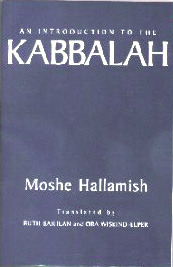 |
| Moshe Hallamish, An Introduction to the Kabbalah, (Albany: SUNY, 1999), 379 pp., $27.95 pb.
Moshe Idel, Messianic Mystics, (Yale UP, 1998), 608 pp., $40.00 cloth Reviewed by Arthur Versluis, Michigan State University Since the death of Gershom Scholem, a number of scholars have continued the central project that he began: to make available sound historical knowledge about Kabbalism and its concepts. Certainly one of the major scholars in this field is Moshe Idel, whose many books include the seminal Kabbalah: New Perspectives as well as this latest work, Messianic Mystics. Idel's work is vast in scope and extremely dense in scholarly detail, and this book is no exception. In it, he continues the pattern of solid historical investigation begun by Scholem, even if he differs on various points with Scholem's interpretations. A very different kind of book is Hallamish's Introduction to the Kabbalah, for if Idel's represents a definitive example of historical research, Hallamish's work represents a thematic introduction to Kabbalistic concepts and traditions. Both are valuable additions to the field. Idel's work focuses on the nature of Jewish messianic and mystical traditions from the twelfth through the eighteenth centuries but includes remarks on the twentieth century, and examines such major figures as Abulafia and Sabbatai Sevi, as well as a host of lesser-known figures, authors, or texts. As in his other books, Idel differs sharply from Scholem in some respects, here arguing that mysticism and messianism are not incompatible as Scholem held, but in fact are complementary, with messianism emerging from mysticism. Idel also argues that messianism does not necessarily require a turbulent period to emerge; messianic figures do appear in relatively calm eras as well. For our purposes so far as the field of Western esotericism is concerned, Idel's book is perhaps most significant for the fact that |
||
 |
| it discusses the connections between magic and messianism, particularly beginning in the fourteenth century. Idel points out that Kabbalists for the first time began to argue "that the advent of the Messiah is not to be accomplished through the fulfillment of biblical commandments or by the perfection of the human intellect, but rather by magical procedures enacted by a group of Kabbalists which will disrupt the continuum of history and cause radical change in the natural order (127)." Such magical procedures included recitation of incantations meant to destroy the demonic realm(s) and to bring about redemption of creation, a prominent originator of this school being R. Joseph della Reina, about whom there are many legends. Magical messianism is only one of the Jewish messianic tendencies that Idel discusses in this book, but it is important because it demonstrates once again an aspect of his book's larger thesis, that one cannot easily separate mysticism, messianism, and for that matter magic in the Kabbalistic tradition. These various kinds or strands of esotericism are intimately tied together when one looks at the historical evidence.
By contrast to Idel's book, which is a paragon of scholarship with more than one hundred pages of dense endnotes, Hallamish's is a book intended to introduce the general reader to Kabbalistic concepts. While the text itself has been translated from the Hebrew by Ruth Bar-Ilan and Ora Wiskind-Elper, the bibliography remains almost exclusively works in Hebrew and is not complete, a likely problem for most in the presumed audience who undoubtedly can only pursue works in translation. Still, for those who wish to use a book in the classroom in order to teach major Kabbalistic concepts, this is a very useful work. It is arranged around themes concerning Kabbalistic practices, including such topics as "Early Preparations," "Dangers Facing the Mystic," "Techniques of Exploring Mysteries," and so forth. Only after the practical section is there a section with chapters on themes like the Sefirot, the Torah, the Soul, and Transmigration. Hallamish's book is one I would certainly recommend for those who would like a reputable, clear introduction to Kabbalistic practices and some concepts, although it is far from an historical overview and in fact |
||
| leaps about quite a bit among various historical figures in explicating its various themes.
In sum: for the historical scholar, Idel's book is yet another major work to consult from the hand of this prolific author; and for classroom use, Hallamish's is arguably one of the best introductory books available. Both are valuable books. |
||